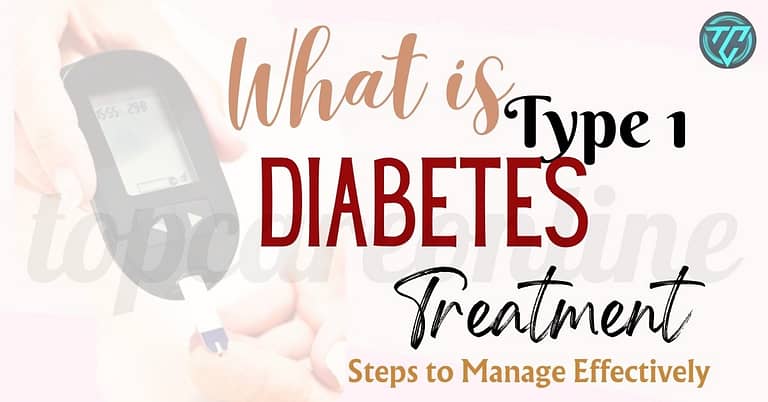Type 1 Diabetes | Symptoms | Treatment | Future Directions in Type 1
We can’t be certain about the root cause of type 1 diabetes but if we maintain some things, we will be able to ensure Type 1 Diabetes Treatment.
What is Type 1 Diabetes
Type 1 Diabetes (T1D) is a chronic autoimmune disorder characterized by the body’s inability to produce insulin. Unlike Type 2 Diabetes, which can be influenced by lifestyle and genetic factors, T1D occurs when the immune system mistakenly attacks and destroys insulin-producing beta cells in the pancreas. This autoimmune response results in insufficient insulin production, causing elevated blood glucose levels.
The exact triggers for this autoimmune attack are not fully understood, but genetics and environmental factors are believed to play significant roles. Certain genetic predispositions can increase susceptibility to T1D, although environmental factors such as viral infections may also contribute to its onset.
Symptoms
Symptoms of Type 1 Diabetes can develop rapidly and include frequent urination, excessive thirst, unexplained weight loss, and fatigue. These symptoms arise from elevated blood glucose levels, which prompt increased urine production to eliminate excess glucose. Without sufficient insulin, glucose cannot enter cells for energy, leading to weight loss and persistent fatigue.
Early detection and management of T1D are critical to prevent severe complications such as diabetic ketoacidosis, a potentially life-threatening condition that occurs when the body breaks down fats for energy due to insulin deficiency.
Recognizing the autoimmune nature of T1D and its symptoms is vital for prompt intervention and effective treatment. Continuous monitoring and early intervention help maintain stable blood glucose levels and reduce the risk of long-term complications associated with the condition.
Type 1 Diabetes Treatment
Managing type 1 diabetes involves multiple aspects to ensure blood sugar levels are controlled effectively and to prevent complications.
Here’s a detailed breakdown of each aspect of type 1 diabetes treatment:
Insulin Therapy:
Short-acting insulin, also known as regular insulin, takes effect within 30 minutes, peaks between two to three hours, and lasts for about six to eight hours. It is often used to cover the body’s insulin needs for meals eaten within 30 minutes of injection and may be combined with longer-acting insulin for comprehensive blood sugar control.
Intermediate-acting insulin reaches the bloodstream about two to four hours after injection, peaking between four to 12 hours, and remains effective for approximately 12 to 18 hours. This type is commonly used to provide baseline insulin coverage throughout the day or night.
Long-acting insulin starts working several hours after injection and maintains a stable, baseline insulin level for up to 24 hours. It is usually administered once or twice daily to maintain consistent blood glucose levels between meals and overnight.
Various methods of insulin delivery are available, offering flexibility and convenience. Syringes are a traditional method, allowing for precise dosing. Insulin pens are more user-friendly, combining the insulin and syringe into a single device. Insulin pumps provide continuous insulin delivery, closely mimicking the pancreas’s natural insulin release.
Monitoring blood glucose levels is crucial for adjusting insulin doses and achieving optimal blood sugar control. Regular monitoring helps in identifying patterns and making necessary adjustments to insulin therapy. This personalized approach ensures that individuals with Type 1 Diabetes can maintain stable blood glucose levels, reducing the risk of complications and improving overall quality of life.
- Administered once or twice daily, depending on the type of insulin (e.g., long-acting insulin like glargine or detemir).
Blood Sugar Monitoring:
- Blood Glucose Meter: Measures blood sugar levels through a drop of blood obtained from finger pricks. Typically checked multiple times daily (before meals, before bedtime, and occasionally during the night).
2. Continuous Glucose Monitor (CGM): Provides real-time glucose readings throughout the day and night.
Offers trends and alerts for high and low blood sugar levels, helping to adjust insulin doses and prevent severe fluctuations.
Meal Planning:
- Carbohydrate Counting: Helps match insulin doses to the amount of carbohydrates consumed.
- Utilizes food labels, carbohydrate counting books, or smartphone apps to calculate insulin-to-carbohydrate ratios.
- Healthy Eating Guidelines: Focuses on balanced meals with whole grains, lean proteins, fruits, vegetables, and healthy fats.
- Limits processed foods and sugary drinks to maintain stable blood sugar levels.
Physical Activity:
- Exercise Routine: Regular physical activity improves insulin sensitivity and helps lower blood sugar levels.
- Monitoring blood sugar before, during, and after exercise to adjust insulin doses or carbohydrate intake as needed.
- Hydration: Staying hydrated during exercise helps prevent dehydration, which can affect blood sugar levels.
Education and Support:
- Diabetes Education: Provides comprehensive knowledge on insulin administration, blood sugar monitoring, meal planning, and managing hypoglycemia.
- Includes sessions with certified diabetes educators (CDEs) and attending diabetes self-management education and support (DSMES) programs.
- Support Groups: Offers emotional support, practical advice, and shared experiences from peers living with type 1 diabetes.
- Provides opportunities to discuss challenges, successes, and coping strategies.
Medical Monitoring:
- Regular Healthcare Visits: Scheduled appointments with healthcare providers (endocrinologists, primary care physicians, diabetes educators) every 3 to 6 months.
- Reviews blood sugar logs, adjusts insulin regimens, screens for diabetes-related complications, and provides vaccinations (e.g., flu and pneumonia vaccines).
- Managing Hypoglycemia and Hyperglycemia:
- Hypoglycemia Treatment: Recognizes and promptly treats low blood sugar levels (typically below 70 mg/dL).
- Uses fast-acting carbohydrates such as glucose tablets, juice, or candy.
- Hyperglycemia Management: Adjusts insulin doses based on blood sugar levels (typically above 180 mg/dL).
- Corrects high blood sugar through additional insulin doses, increased water intake, and monitoring ketone levels if necessary.
Diabetes Technology:
- Insulin Pump: Delivers continuous insulin throughout the day, mimicking the action of a healthy pancreas.
- Adjusts basal rates and delivers bolus doses based on mealtime insulin needs.
- Continuous Glucose Monitor (CGM): Provides real-time glucose readings and trend data every 5 to 15 minutes.
- Alerts for impending high or low blood sugar levels, improving management and reducing the risk of severe hypoglycemia.
Managing Stress and Mental Health:
- Stress Management: Incorporates relaxation techniques (e.g., deep breathing, mindfulness, yoga) to reduce stress levels.
- Considers seeking support from mental health professionals (psychologists, counselors) for additional coping strategies and emotional support.
Complications Management:
Each aspect of type 1 diabetes treatment plays a crucial role in maintaining stable blood sugar levels, preventing complications, and supporting overall health and well-being. Collaboration with healthcare providers and adherence to the treatment plan are essential for effectively managing type 1 diabetes and optimizing quality of life.
Advancements and Future Directions in Type 1 Diabetes Treatment
Recent advancements in the treatment and management of Type 1 Diabetes have transformed care, enhancing quality of life and offering hope for improved outcomes.
Key developments include:
- Insulin Therapy Innovations:
- Artificial Pancreas Systems: Combine continuous glucose monitors (CGMs) with insulin pumps to automate insulin delivery based on real-time glucose readings, mimicking the pancreas’s natural function.
- Search for a Cure:
- Beta Cell Transplantation: Involves transplanting insulin-producing cells into the pancreas, showing potential to restore insulin production. Challenges include immune rejection and the need for immunosuppression.
- Immunotherapy: Aims to modulate the immune system to prevent it from attacking insulin-producing cells, addressing the underlying cause of Type 1 Diabetes.
- Technological Advancements:
- Continuous Glucose Monitors (CGMs): Provide real-time glucose readings and trend data, integrated with mobile health applications for better management and personalized treatment plans.
- Mobile Health Applications: Facilitate tracking of diabetes metrics, adherence to treatment protocols, and communication with healthcare providers, enhancing overall disease management.
These innovations represent significant strides in managing Type 1 Diabetes, offering more effective therapies, potential pathways to a cure, and improved tools for daily management and monitoring.
Looking ahead, the future of Type 1 Diabetes treatment is filled with promise. Ongoing research aims to refine these advancements and explore new avenues for treatment and potential cures.
As technology continues to evolve, the management of Type 1 Diabetes is expected to become increasingly seamless, offering improved outcomes and a better quality of life for those affected by this chronic condition.



